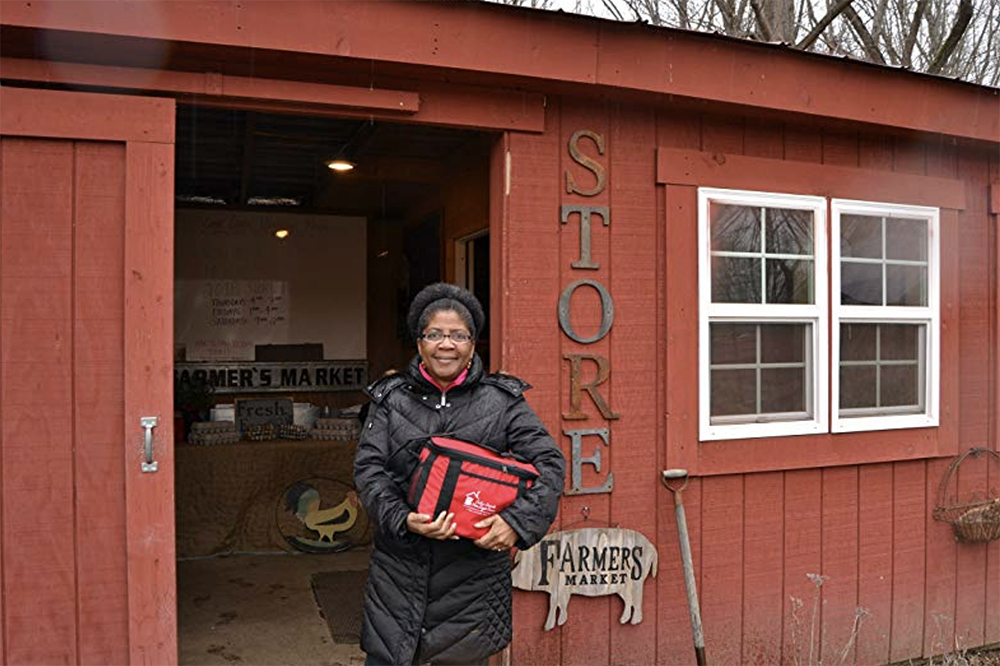
Renee Brooks Catacalos knows a thing or two about local food. She served as the deputy director of Future Harvest-Chesapeake Alliance for Sustainable Agriculture, published and wrote for Edible Chesapeake magazine from 2006 to 2009, and has eaten almost exclusively locally for over a decade.
Her first book, The Chesapeake Table: Your Guide to Eating Local, will be released in October and outlines why she’s been hooked on the local food movement from the start, which foods you can only find in the Chesapeake region, and how you can benefit from the fruits—literally and figuratively—of local farmers’ labors.
You’ve been working with local food for years now. Where did you start?
My interest in local food started as a consumer, actually. I’d lived abroad in my twenties in places where eating local is pretty common, but when I moved back to DC in 2001, farmers markets and “eat local” campaigns were really starting to take off. I was a little skeptical at first, but I found that shopping and eating locally was a lot of fun. It was so interesting to find out where the food comes from and talk to the suppliers about how they grow and care for it all, and it all tasted incredible, like noticeably more flavorful than food from a lot of grocery stores.
In addition to taste, what are some other benefits of eating locally?
There are so many! The health and environmental benefits are some of the most important for me, because when you buy locally grown food, especially meat, you’re choosing not to support industrial farms that use a lot of toxic chemicals. There are even socioeconomic benefits. Right now, eating locally is a little more expensive, but in order to allow a broader range of people access to healthier, seasonal, well-raised food, we have to buy it so that it’s economically viable for the farmers to continue making it and eventually lower the prices.
Giving up the convenience of going to the nearest supermarket and eating largely locally grown food can seem daunting.
Yeah, lots of people are definitely daunted by it beforehand, mostly because they feel like they don’t have the time, the know-how, or the money to do it. But it’s really like any other food-specific commitment, like being a vegetarian, or a vegan, or kosher, or gluten-free, except this one doesn’t have to be all or nothing. Even if you just get to the farmers’ market once a month to buy a box of peaches or if you know the grocery store stocks local honey, that’s a great place to start.
What does The Chesapeake Table bring to the conversation about local food?
One of my biggest frustrations with other books on local food is that so many of them take a really broad, national viewpoint, and that’s hard to translate into a real game plan for consumers. That’s why I wanted to take this regional focus and be much more specific about the Chesapeake region, because there is so much the Chesapeake offers us in terms of local food. My book also comes from a consumer perspective, which is sort of rare. I don’t work directly in the industry anymore, and it’s hard to balance a job that is not related to food with trying to shop and cook and support the local food system, but it gave me a unique perspective.
This book isn’t everything you’ll ever need to know about local food, but I thought it could give people a good starting point with information about the local food system and the Chesapeake region, and hopefully it’ll prime them to keep learning on their own.
So why is the Chesapeake such a great place to eat locally?
I don’t think people appreciate how special the Chesapeake Bay actually is. Because it’s a mix of salt and fresh water, it creates such a fertile place where so many kinds of food can thrive. The seafood, of course, is the sweetest and the biggest because they put on fat during cold winters, and because this climate gets four distinct seasons, we get this extensive range of seasonal produce. Basically, we have anything except tropical foods. You can source almost a complete diet from this region.
What about Baltimore specifically?
Baltimore has a level of infrastructure to support the local food industry that a lot of other cities don’t have yet. In the past decade, the city has started to put money toward funding local farmers, and that’s legitimized that system in both a symbolic and a tangible way. Also, because of its size and diversity, both in the foods that are sold and the people that buy them, the Baltimore Farmers’ Market is one of the best I’ve ever been to, and I’ve been to a lot.
You’re from D.C., but do you have favorite places around Baltimore to eat local food?
Well, of course, I love Woodberry Kitchen and Gertrude’s, but farm-to-table doesn’t have to refer to that new American kind of food. Ananda in Howard County is an Indian resturant, and they have their own garden. There’s also a great website called Chesapeake Farm to Table that’s run by of Calvert’s Gift Farm in Sparks, and it lists a bunch of restaurants around Baltimore that source their food straight from that farm.
The term “farm-to-table” is everywhere now. How do you distinguish what’s legitimate?
The farm-to-table claims can get so ridiculous! I’ve seen peach gummy candy—obviously not farm-to-table since it’s entirely chemicals—labeled as “locally sourced.” A good way to know for sure is just to ask. If restaurants are serving local food, they should easily be able to tell you where the ingredients came from.
Unfortunately for Baltimoreans, most crab cakes are not made entirely with local blue crabs, so if you want something that you can know for sure is straight from the bay, buy crabs in the shell, in their whole, full glory. They taste so much fresher, and then you know exactly what you’re eating because you can see it.
Why is now the right time for this book?
Anniversaries are definitely times to reflect, and it had been about 10 years since I’d gotten into local eating when I came up with the idea for The Chesapeake Table. I started doing a lot of research and thinking a lot about what had changed in the decade, especially as I left the industry and began to look at things as a consumer.
I really am committed to the local food system, and I wanted to contribute something to it that would help it grow. I’m not reinventing the wheel. I’m just bringing light to how much work people are doing to bring local food to people’s dinner tables, and I’m trying to show people that even the tiniest things can make a big difference.
